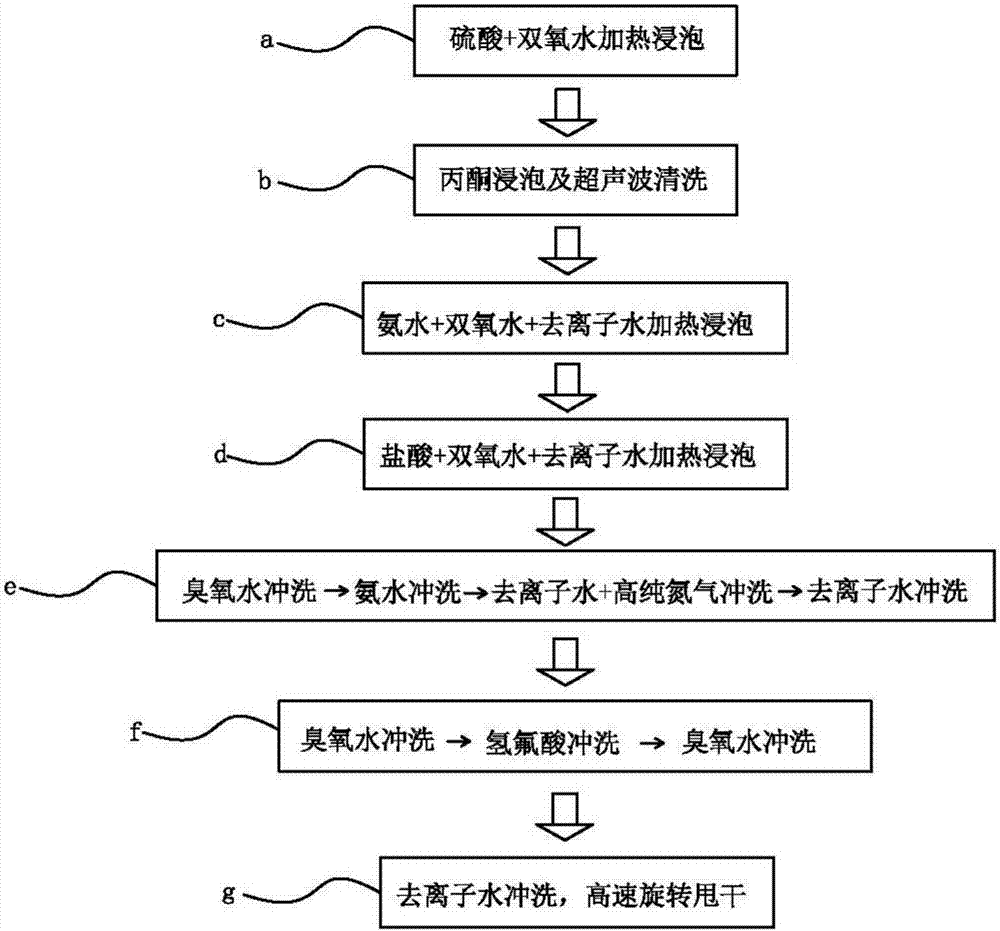Cleaning method for removing metal pollution or residuals of SiC epitaxial wafer
A technology of epitaxial wafers and metals, applied in the direction of electrical components, semiconductor/solid-state device manufacturing, circuits, etc., can solve the problems of reducing breakdown voltage, shortening the lifetime of minority carriers, affecting the reliability of semiconductor device performance, and device yield, so as to prevent Secondary contamination, reduction of re-contamination by metals, and prevention of adsorption of secondary pollutants
- Summary
- Abstract
- Description
- Claims
- Application Information
AI Technical Summary
Problems solved by technology
Method used
Image
Examples
Embodiment 1
[0042] combine figure 1 As shown, this embodiment one uses steps a, b, c, d, and g in the above-mentioned cleaning method for removing metal contamination or residues on SiC epitaxial wafers, and the test results of two samples in this embodiment one show: Calcium (Ca) residue The minimum value is 3.241E+11atom / cm 2 , the maximum value is 1.1623E+12atom / cm 2 ; The minimum iron (Fe) residue is 1.58E+10atom / cm 2 , the maximum value is 6.74E+10atom / cm 2 ; The minimum zinc (Zn) residue is 5.53E+10atom / cm 2 , the maximum value is 1.281E+11atom / cm 2 ;The residual content of other metal elements is less than 5E+10atom / cm 2 , see the test value image 3 .
Embodiment 2
[0044] combine figure 2 As shown, the present embodiment 2 uses steps a, b, c, d, e, f, and g in the above-mentioned cleaning method for removing metal contamination or residue on SiC epitaxial wafers. The test results of the two samples in the present embodiment 2 show: the sample 04 (Sample 04) The content of potassium (K) and calcium (Ca) in the central point is relatively high, and the other test points are all less than 5E+10atom / cm 2 ; The minimum iron (Fe) residue is less than 0.45E+10atom / cm 2 , the maximum value is 0.88E+10atom / cm 2 ; The minimum residual amount of zinc (Zn) is less than 0.21E+10atom / cm 2 , the maximum value is 1.41E+10atom / cm 2 ;The residual content of other metal elements is less than 2E+10atom / cm 2 , see the test value Figure 4 .
[0045] Embodiment 2 has a better effect of removing metal pollution or residue, and the result meets the material requirements of the semiconductor industry.
PUM
 Login to View More
Login to View More Abstract
Description
Claims
Application Information
 Login to View More
Login to View More - R&D
- Intellectual Property
- Life Sciences
- Materials
- Tech Scout
- Unparalleled Data Quality
- Higher Quality Content
- 60% Fewer Hallucinations
Browse by: Latest US Patents, China's latest patents, Technical Efficacy Thesaurus, Application Domain, Technology Topic, Popular Technical Reports.
© 2025 PatSnap. All rights reserved.Legal|Privacy policy|Modern Slavery Act Transparency Statement|Sitemap|About US| Contact US: help@patsnap.com



